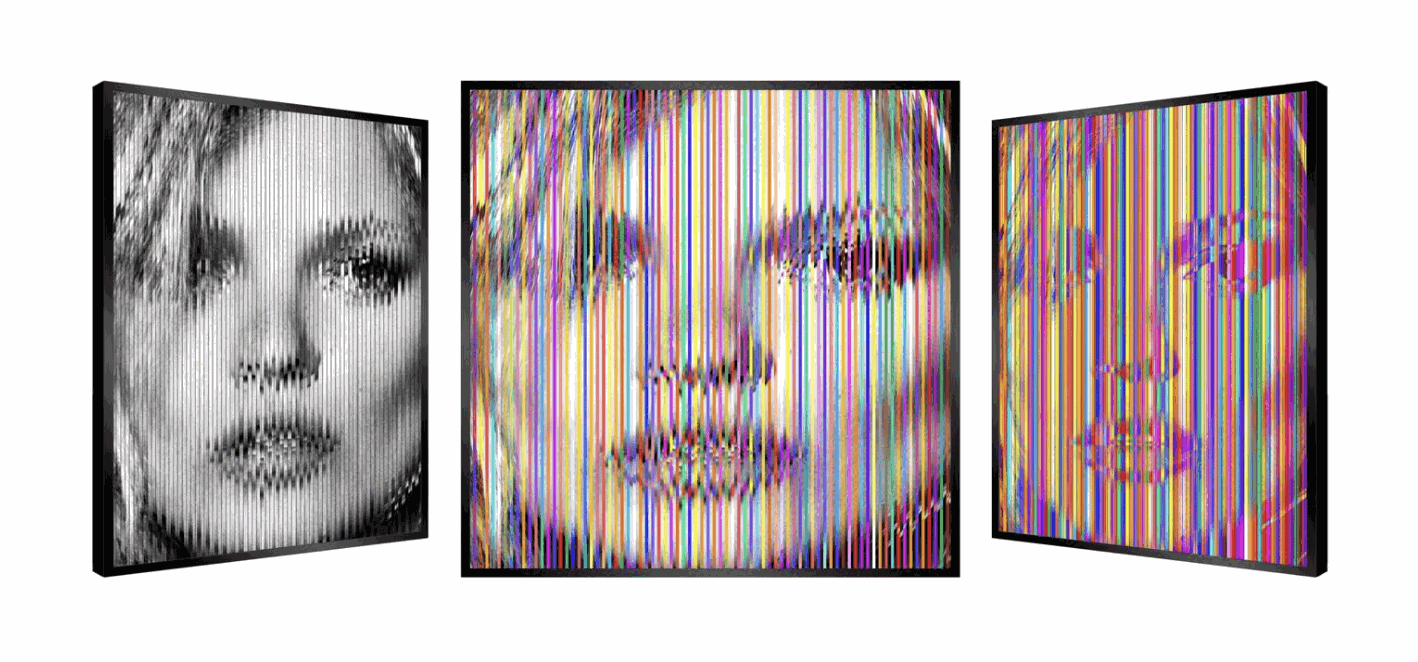
At Markowicz Fine Art, we are continually curious about what is the relationship between art and technology, especially as our represented artists explore kinetic, digital, and AI‑enhanced expression. From experiential sculpture to generative visuals, our roster is at the forefront of this creative convergence.
1. Kinetic Illusion Meets Optical Precision
Take Patrick Rubinstein, whose kinetic sculptures engage art and technology by merging Op Art’s visual tricks with mechanical motion. His pieces create shifting optical patterns that blur perception. Thanks to cleverly engineered structures, they seem to come alive in rhythm and motion. In Rubinstein’s practice, movement becomes medium, and the viewer becomes a participant.

Patrick Rubinstein, "Stripes of Kate", 2019
2. Digital Canvas and Physically Printed Code
Some represented artists are blending generative code, digital process, and traditional media. For instance, Leo & Steph produce digital prints mounted on plexiglass – a physical manifestation of a virtual creation. These digitally‑born works highlight the evolving question of what a digital artwork can be and how collectors integrate it, as reflected in our recent blog post introducing the digital frontier in art collecting.
Elsewhere, artists who incorporate digital aesthetics – whether via projection, mixed‑media overlays, or image manipulation – are reshaping expectations of what defines painting or sculpture in the digital era.

Leo & Steph, "Kidcup Basquiat", 2024
3. AI‑Enhanced and Generative Explorations
While our gallery does not specifically showcase AI artists like Gretchen Andrew or Sougwen Chung, their broader practices offer insight into the wider dialogue around AI in art – helpful context for how contemporary creativity is evolving. Gretchen Andrew, for example, explores how AI‑inflected “beauty standards” can be subverted through traditional painting, making invisible digital pressures visible. Sougwen Chung, meanwhile, collaborates with robotic arms that learn from her drawing gestures in real time, raising questions about human‑machine synergy and agency in creation. These pioneering approaches offer compelling context for the relationship between art and technology, especially as more artists experiment with generative and interactive systems.
4. Markowicz Artists Embracing Hybrid Tools
Artists in our lineup who bridge technology and traditional craft are forging hybrid forms:
-
Arno Elias integrates digital manipulation – like hand‑embellished photographs with diamond dust and gold leaf – with environmental storytelling, offering immersive visuals that respond to both nature and technology.
-
Kaï, known for bold street and pop sculpture, has experimented with NFT-based works (e.g. “My Imaginary Friend” NFT), turning digital formats into collectible art forms that reflect the blockchain era.
-
Emerging digital print works like those by Lyès‑Olivier Sidhoum and Leo et Steph fuse crystal acrylic, pigments, or digital printing on sculptural surfaces, uniting high‑tech fabrication with fine art sensibility.

Lyès-Olivier Sidhoum, "Irradiance Unveiling"
5. Understanding the Relationship Between Art and Technology
What is the relationship between art and technology today? More than ever, the two are intertwined:
-
Technology expands the artist’s toolkit – from mechanical kinetic systems, programmable LEDs, and projection mapping, to generative code and AI models.
-
Art humanizes technology, using it to express emotion, critique digital culture, or create sensory experiences.
-
Collectors and galleries adapt too – embracing new forms like digital prints, NFTs, AR installations, or algorithmic art, curated and framed for long‑term appreciation. Our recent guide for digital collectors explores both practical and conceptual elements of acquiring and displaying such works
6. Why This Matters at Markowicz Fine Art
At Markowicz, our mission is to elevate works that challenge and inspire. When artists incorporate kinetic engineering, algorithmic generation, or AI‑inflected aesthetics, they expand the boundaries of traditional media, inviting collectors and audiences to rethink art’s role in the digital era.
We believe art and technology belong together in ways that enrich human experience, and our gallery continues to seek out voices redefining those intersections – whether through motion, code, hybrid sculpture, or digital installations.
Join the Conversation
If you're curious about collecting works that blend the digital with the tactile – sculptures that shift in real time, prints sourced from generative processes, or artists engaging AI tools – feel inspired to explore. Reach out, and let us introduce you to exciting pieces.





